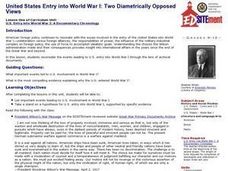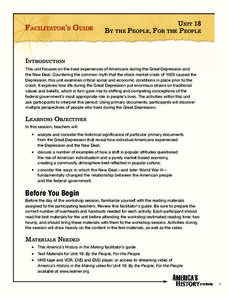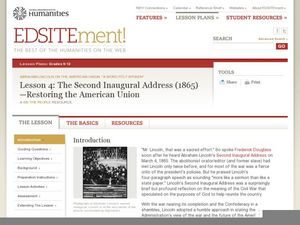Stanford University
Explosion of the Maine
An intriguing lesson features newspaper articles to help academics understand the political impact of the sinking the Maine and how the American media depicted the event. Scholars also view a presentation, participate in group...
Curated OER
Saddam Hussein and Modern Iraq
Take your class through a moment in modern history in this presentation, which details the rise of Saddam Hussein and the dynamics between Iraq and its neighbors during the Persian Gulf War and the current Iraq war. Though slightly...
Curated OER
United States Entry into World War I: Two Diametrically Opposed Views
Learners analyze the events leading to U.S. entry into World War I. They read a speech by President Wilson and an opposition speech, list the reasons each gives for American entry into the war, and complete a Venn diagram.
Curated OER
Cartoons for the Classroom: Obama as the New Sisyphus
Reveal how Greek Mythology can play into American politics through this political cartoon, where President Obama is depicted as Sisyphus. Background information gives scholars access to the cartoon's context, and three talking points...
Theodore Roosevelt Association
Interpreting the Past; Assessing Its Impact on the Present
Even though the presidency of Theodore Roosevelt ended over 100 years ago, we can still learn something from his stances and policies that is applicable today. Class members first look over a list of prevalent political issues from the...
Stanford University
Public Housing
The Fair Deal was meant to give Americans after World War II a basic standard of living. Those in public housing often found that promise fell short. Learners consider whether the effort was successful by evaluating images, testimonies,...
Curated OER
"Police Action": The Korean War, 1950-1953
Students investigate facts about the war in Korea in the 1950's and attempt to classify American foreign policy as a triumph or a failure. Why the U.S. became involved and the unpopularity of the war in America forms the focus of this...
Curated OER
The War of 1812: Ch 6
Explore the causes and results of the War of 1812. Covered are reasons the war began, changing presidency, major battles, and The Treaty of Ghent. This presentation could be appropriate for grades 5-8, but could work for high school...
National Endowment for the Humanities
Lesson 1: The United States Confronts Great Britain, 1793–1796
After the Revolutionary War, the success of the United States was far from guaranteed. Foreign powers coveted the new land, and Great Britain challenged American sovereignty. Learners consider the challenges facing the new nation using...
Museum of Tolerance
The Pursuit of Democracy and Diversity: The Trial of Pro-Social Injustice in Historical Documents and Accounts
Class members investigate The Indian Removal Act of 1830, U.S. Theft of Mexican Territory Timeline, and President Abraham Lincoln’s letter to Horace Greeley, 1862, and then conduct a mock trial of each of these documents to determine...
Scholastic
Dear Miss Breed
This compelling plan based on the letters in the book Dear Miss Breed engages readers in learning what it was like for Japanese Americans following the attacks at Pearl Harbor. After reading the letters, young scholars will partake in...
Annenberg Foundation
By the People, For the People
A picture speaks a thousand words—no matter how old. The 18th installment of a 22-part series on the making of American history has scholars research the causes of the Great Depression and the factors of the New Deal. Using photographic...
ProCon
Cuba Embargo
President John F. Kennedy bought 1,200 Cuban cigars the night before he enacted the Cuban trade embargo in 1962. Should the United States maintain the embargo? Using the website, pupils explore the topic to prepare for a class debate or...
Curated OER
The Civil War (1861-1865) Through Maps, Charts, Graphs, & Pictures
True to its titles, this engaging and appealing presentation brings the 1860's into close focus with a number of images and statistics that would delight any Civil War buff. A few graphs allow for pupil input, such as listing the...
Historical Thinking Matters
Social Security: 1 Day Lesson
Should the United States provide relief for those who are unemployed? Trace this question back to the Great Depression with your young historians, who will engage in careful reading of historical documents and classroom discussion to...
Friends of Fort McHenry
Was the War of 1812 Our Second War of Independence?
Though it occurred almost 40 years later, could the United States have been fighting for their independence again in the War of 1812? Using appropriate primary source material from each of the two wars, compare and contrast the situation...
Reading Through History
Anti-Federalist Paper No. 47
The path to a more perfect union was rockier than most history books would lead you to believe. Young historians read “Antifederalist No. 47,” written by James Madison (under the pen name “Centinel”), which sharply criticizes the...
Anti-Defamation League
Shirley Chisholm: Unbought, Unbossed and Unforgotten
A 13-page packet introduces high schoolers to a lady of amazing firsts. Shirley Chisholm was the first Black woman elected to Congress, the first Black woman to run for President of the United States, and a leader of the Women's Rights...
Curated OER
Lesson 2: The First Inaugural Address (1861)—Defending the American Union
Students explore the content of Abraham Lincoln's First Inaugural Address. In this Abraham Lincoln lesson, students analyze the text of the speech to determine how Lincoln sought to preserve the Union from secession attempts.
Curated OER
The Second Inaugural Address (1865)—Restoring the American Union
Students explore the content of Abraham Lincoln's Second Inaugural Address. In this Abraham Lincoln lesson, students analyze the text of the speech to determine how Lincoln sought to reconstruct the country as the Civil War drew to a close.
Curated OER
Electing the U.S. President
In this reading comprehension worksheet , students read a factual essay about the American election process. Students then answer 7 questions about this information.
Curated OER
The Gettysburg Address (1863): Defining the American Union
Learners explore the Gettysburg Address. In this U. S. history lesson, students examine Abraham Lincoln's speech and it's themes of freedom, equality, and emancipation.
Curated OER
U.S. Constitution - Selecting the President
Learners study how the electoral college works to select a U.S. President. In this history lesson, students examine the U.S. Elector College methods then answer questions and write an essay that relate to the state where they live.
National First Ladies' Library
All the News That's Fit to Draw: Political Cartooning and the Presidency
Young scholars research, analyze and study the history of political cartooning in the United States. They recognize a political cartoon, be able to identify the main idea, the symbols and the exaggeration and caricature in political...
Other popular searches
- Famous American Presidents
- American Presidents Report
- First American Presidents
- List American Presidents
- Recent American Presidents
- American Presidents Order
- Frost American Presidents
- American Presidents Puzzles
- Frist American Presidents

























